Fragments of the bodies of thousands of convicts constantly decorated the gates, bridges and walls of European cities. But exposing the effects of meeting the executioner to the public was only the final chord of the spectacle of justice. What were the last hours of the tormented traitor?
The transport of the condemned man to the place of execution was the first opportunity to disgrace him. In the 14th century, only a few sat on a special outdoor cart. Most of the unfortunates were tied to ponytails and naked or wrapped in cowhides were wandered on the ground rough streets.
In this already entertaining journey, care was taken not to neglect the main character too much. From time to time the procession stopped to administer the ritual flogging, and in the case of traitors to jerk the body with burning tongs and pour hot oil into the wounds or tar. 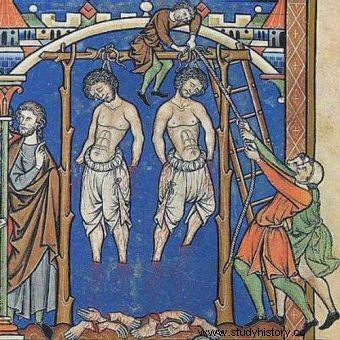
By inflicting physical suffering, special attention was paid to strip the condemned man of dignity and honor. The proud aristocrats were deliberately dressed in torn rags and a crown of nettles, and ordered to ride a battered jade or a donkey.
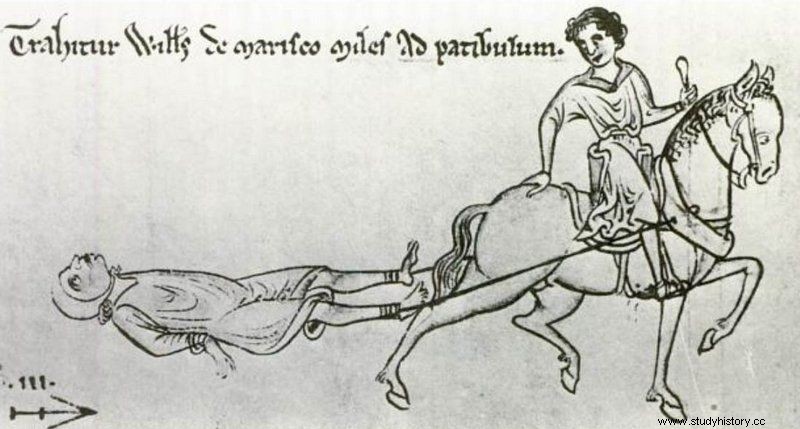
The chasing horse is just an introduction to further torture ... (execution of William de Marisco of Matthew Paris's Chronica Major, public domain).
In 1323 in England, Andrew Harclay was stripped of the title of Lord Carlisle before his execution, then stripped of spurs and a sword belt, and finally branded on his forehead with the expression of a rogue ( knave - play on words with the word knight ). For a man of his type, however, the biggest blow was the inversion of the coat of arms, bringing indelible disgrace to the entire family.
Traitor dies three times
Crowded at the scene of the execution, the audience eagerly awaited the course of the multiple death penalty. The traitors awaited both hanging and beheading, and dismantling . Keeping the main character alive so that he could experience at least most of the attractions provided to him was a real challenge for the executioner.
It is true that in some lands it is customary to pardon a person who, by God's order, survived the third (sic!) Blow to the neck or broke off the noose. In the case of punishment for treason of the ruler, there was no room for such surprises.
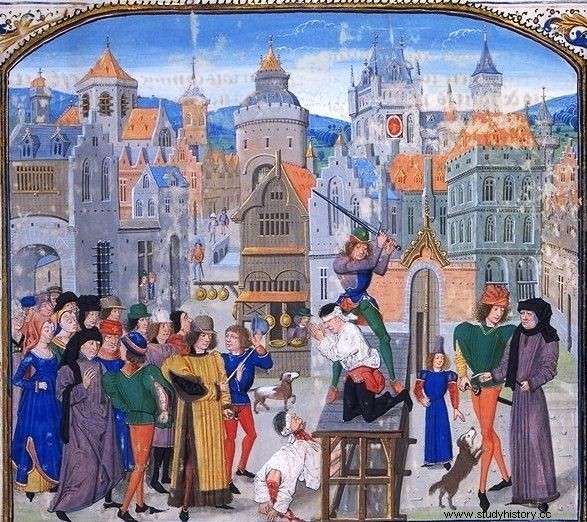
It often took a few blows with an executioner's sword to beheaded ... (painting from Froissart's "Chronicles", early 15th century, public domain).
This does not mean that everything was going smoothly. When in 1356 Jean d'Harcourt, famous for his excessive carcass, found himself on the scaffold for conspiracy against the King of France, John the Good, the unfortunate executioner needed as many as six strokes to separate the magnate's head from the rest of his body .
The understandable emphasis on the inevitability of punishment meant that in the case of the perpetrator's physical absence, his image was 'killed'. In 1477, a realistic effigy of the treacherous prince of Orange was hung by the left leg on the Paris gallows. At the same time, the smallest details were reproduced, reproducing the insides pouring out of the body, flames covering the traitor's head, and even the figure of a devil tearing his tongue out of the "condemned man" throat.
Kitchen execution
The use of a short rope to hang the victim condemns the victim to slow, disgraceful agony. At the right moment, however, the half-dead man was cut off. According to historians, the subsequent quartering was intended to strip the victim of human form and was difficult to survive until beheaded.
A chronicler describing the death of Simon Pouillet in 1346, condemned for an indiscreet discussion of Philip Valois' right to the French throne, emphasized it vividly: Body his , like a piece of meat in a butcher's shop, it was stretched over a long wooden counter, separating the arms from the torso, then the legs and head .
In some cases, the gutting act was performed. The cut out entrails, in particular the heart symbolizing the noble status, were thrown in the face of the victim. Therefore, efforts were made to adapt a wide arsenal of cruelty to the nature of the committed crime and the status of a convict.
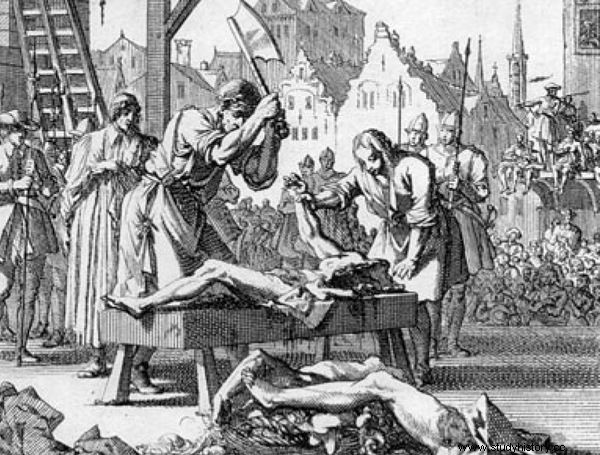
A good execution could not be complete without the dismemberment of a half-living body (the picture shows the execution of Thomas Armstrong in 1684, public domain).
It was natural for everyone that Hugh Despenser, suspected of having intimate contacts with the King of England, Edward II, was stripped of his sexual organs during the dismemberment. In turn, for the special shame of the Count of Flanders, William III, he was placed on a gallows without pants, and his intestines were wrapped around his neck . After all, the body woven into the execution wheel froze in an intimate embrace with another previously killed conspirator ...
Death is not enough
As you can see, the posthumous fate of the condemned man was not indifferent to the whole show. An inseparable element of the punishment for treason and regicide was exposing the corpse to public view. In England, from the end of the thirteenth century, the limbs of rebels like William Wallace or Daffyd ap Gruffydd were sent to the main cities of the kingdom, where for years they testified to the fate of those who dared to raise their hand against the king.
As a rule, the head was reserved for the capital, where it most often ended up on the famous London Bridge. In later times, a separate official ( Keeper of the Heads ) controlled the entire described procedure, supervising, inter alia, head maintenance process which, thanks to being immersed in tar, had a chance to survive for several dozen years.
In an earlier era, the body of a fallen enemy was used as a trophy. After the Battle of Evesham (1265), the henchmen of Henry III of England did not stop at butchering the corpse of the leader of the anti-royal opposition, Simon of Montfort. His genitals placed on the severed head were immediately sent as a gift wife of Roger Mortimer, the crown's chief supporter.
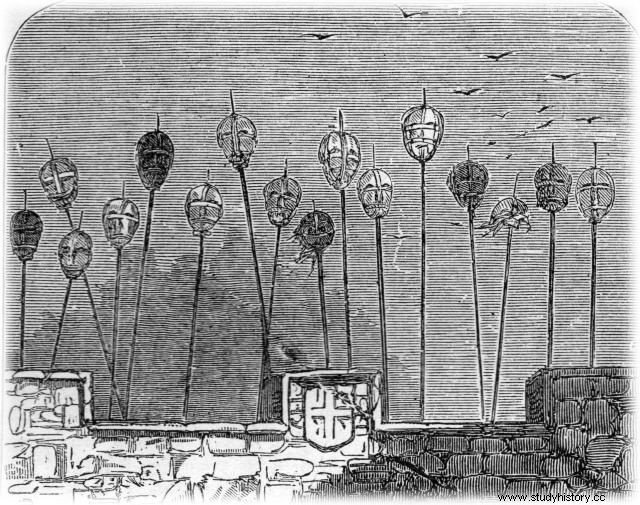
A forest of heads at London Bridge. After all, the most valuable trophies went to the capital (source:public domain).
The decision to desecrate a corpse sometimes caused real controversy. When Richard II learned that the nearby Augustinians had buried Lord Arundel completely, he sent his men to exhumate and cut off the traitor's head attached by the monks again.
Similarly, in 1381, the residents of St. Alban, who removed from the scaffold and buried the bodies of the participants of the Wat Tyler uprising, were forced to hang the decaying bodies on their own. Ultimately, however, the goal of each execution was to destroy the traitor, and it was only up to the authorities when that would happen.
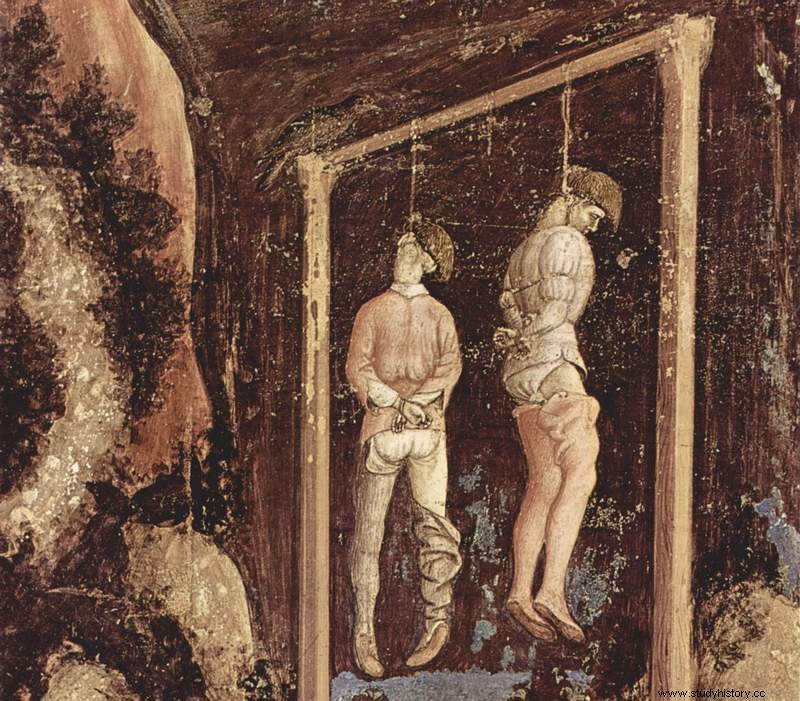
Unfortunate, decaying bodies were often hung by former colleagues ... (a painting by Antonio Pisan "The Hanged Man" from the 14th century, public domain).
In the case of Hugh Despenser the Elder, after three days of hanging on a noose, his body was dismembered and thrown to the dogs to be eaten. It was also typical to scatter ashes in the wind, sometimes, like in the case of Urlich Zwingli, mixed with the remains of a pig. For a fuller understanding of the purposefulness of all these treatments, it should be mentioned that among the contemporaries was convinced that the deceased felt pain for many months after death ...
People's anger
Not all executions were carried out as planned by the legal authorities. It is striking, however, that the justice of the crowd, close to common lynching, tried to recreate the symbolism of "official" executions.
For example, in 1476 the body of a conspirator plotting against the Duke of Milan was wandered through the streets of the city by the local youth, suspended by one leg on the scaffold, finally cut into pieces and thrown to pigs to be eaten. It was not without a little cannibalism, as the shocked chronicler admitted, some residents did not hesitate to dip their teeth into the traitor's heart .
Let us dwell for a moment on this characteristic phenomenon. If you believe the chroniclers, the inhabitants of the Italian city of Todi simply ate the tyrant, Altobello di Chiaravalle, which was overthrown in 1500. But let's not judge these Umbrians too harshly. According to the research of Richard Sugg, consumption of meat, blood and other body fluids from the body of a convict was a recognized medical measure in the 16th century …
The most complete description of the ceremony of killing a tyrant and a traitor is found in the case of Concini Concini, the gray eminence of the court of the minor king of France, Louis XIII. The body of the murdered minister did not stay in the rich sarcophagus for long. The day after the funeral, they were hauled out by a gang of teenagers and wandered as usual through the streets of Paris.
At one point, the peculiar procession stopped in front of the statue of Henry IV, where the former minister was placed in a kneeling position, recreating the custom of the condemned to plead for royal forgiveness. Immediately afterwards the body was mutilated, including castration to bring the remains together in a merry parade.
At that time, many people found their way to the mouths of Parisian commoners and a herd of stray dogs, but the especially valued heart was made on hot coals . The whole thing looks like a careful measurement of the outstanding execution. Historians see this as a symbolic ritual of dethronement, which is a reversal of the triumphal procession of the newly elected ruler.
Termination
Someone will say:all this is old history. Similar bestialities in the majesty of the law will seem less distant, however, when we realize that as late as 1822 in Spain, there was a penalty of dequaling, that is, tearing the scalp along with the hair …
